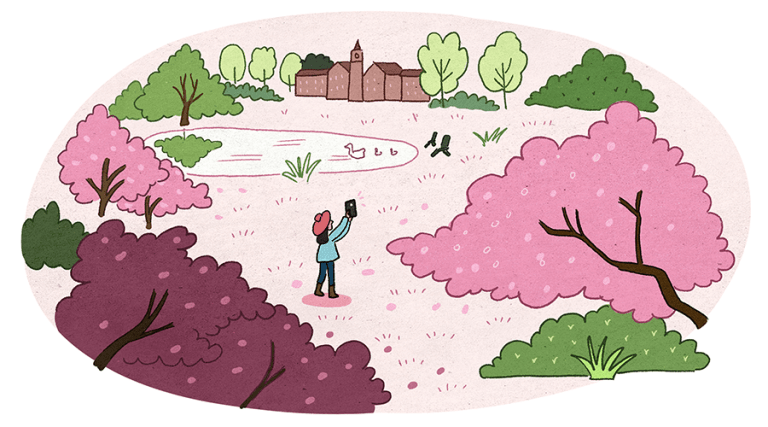Remote teaching with Kyae-Sung Park: Closing the distance
Kyae-Sung Park, Five College Lecturer in Korean, faced a unique challenge when her students dispersed, as most of them returned to homes halfway around the globe.
To meet the needs of her two sections of first-year Korean, one section of second-year Korean and her student workers, Park implemented a hybrid approach, marrying asynchronous remote learning opportunities with small-group synchronous meetings for students set in different time zones. Most days, she works upward of 16 hours to ensure her students are learning.
But that’s not all: To maintain her students’ connection with each other and with Mount Holyoke, Park takes video tours of the campus and its blooming flowers and creates videos of herself cooking Korean food to help her students cope with stress and boredom.
Many of your students live overseas. Have some of them stayed on campus? How has the transition been for those who have left to return home?
Only four or five students have stayed on campus. Most of my international students returned to their home countries of Vietnam and China, where they were put in quarantine for two weeks. They are all out of quarantine now and they are staying at their homes.
How are you working with so many students around the world?
To maintain fairness, I decided not to have Zoom meetings for the whole class. Instead, I divided the class into small groups of three to five students who are in the same time zone. I have breakout meetings with each group weekly.
Some of my students asked me to pre-record my lecture slides for them, which I did. I created folders on Google Drive where I upload my lecture videos and I post my PowerPoint presentations on Moodle.
I kind of adopted a hybrid of synchronous and asynchronous approaches, which means I am up from early morning until my last meeting at 10 to 11 pm.

What are some of the challenges and successes you've had in adapting this hybrid model?
I would say one of the biggest challenges is that some of my students who were in quarantine were not able to access the internet completely, but now they can access the internet through virtual private networks.
As far as successes, by dividing the whole class into groups, I have had weekly meetings with my students so that, in a way, they can have synchronous meetings with me.
Another reason I implemented breakout meetings was that the student assistants working in the Korean Language Program wanted to continue to work. So I’m having them run breakout discussion sessions. I provide them with PowerPoint presentations for each session and set up the times. I attend all the meetings to help the student assistants, answer questions and check on students’ progress.
I haven’t had a chance to evaluate my students’ level of satisfaction or receive their feedback, but I think these sessions help with their online learning.
What, if anything, have you sort of discovered in the process of changing your in-class teaching that you might bring back when “normalcy” returns?
I was already using Moodle as an essential teaching tool to upload the materials and communicate with my students. I have used it to upload teaching slides immediately after class, make announcements, check my students’ attendance, receive assignments, give feedback and upload grades. My students also use the site on a daily basis.
It was not difficult for me to change and move my classes to an online platform. The one major difference is that I am using a new technology to record my lectures and I make about six videos per week for my students. It's challenging and time-consuming for me to do so. But it also gives me a new opportunity to reflect on my teaching by recording my lectures and watching them. I think it has been very helpful for me to improve my teaching and upgrade my PowerPoint presentations.